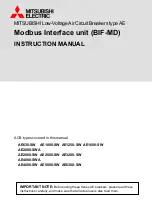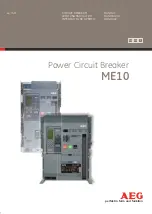
MicroVersaTrip Plus™ and MicroVersaTrip PM™ Trip Units
Chapter 4. Status Mode
29
4-1 Overview
Trip Unit Status mode is selected by pressing the
FUNCTION
key until
STATUS
appears on the display.
Status mode indicates the present status of the Trip
Unit and circuit breaker. It also displays information
about trip conditions and the trip history of the
breaker. Two categories of information can be
displayed: trip information and trip operations
counters.
Trip Information
Various trip information parameters are displayed
when an overcurrent trip or protective relay trip
occurs. Additionally, RMS9D series Trip Units pro-
vide target indications if a breaker Undervoltage
Release or Shunt Trip accessory trip occurs.
The Status display indicates when a long-time, short-
time, or ground-fault trip is imminent (breaker is in
pickup). Following a trip, the Trip Unit displays a
trip target to indicate the type of trip, the fault cur-
rent magnitude at trip, and the phase of the fault
(where appropriate). For adjustable-instantaneous
trips, the Trip Unit displays the instantaneous func-
tion setpoint rather than the actual current. Fault
magnitude is not displayed for high-range instanta-
neous trips.
Trip information is stored in the Trip Unit memory
and displayed when Trip Unit power is returned or if
internal battery power is enabled. Trip information
is always available if Trip Unit power is maintained
following a fault.
The Status display records trip information only for
those options ordered with the Trip Unit. For exam-
ple, only MicroVersaTrip PM Trip Units can be
equipped with protective relays and thus display
information about them.
RMS9D series Trip Units only display trip targets for
Undervoltage Release and Shunt Trip accessory trips
when those accessory modules are installed in the
Power Break® II breaker.
Trip Operations Counters
Trip operations counters record the total number of
overcurrent trips. Separate internal counters are
provided for each of the following types of trips:
long-time, short-time, adjustable-instantaneous, and
ground-fault. The corresponding counter is incre-
mented after any of these trips. A maximum of 256
trips can be counted for each type of fault, after
which the counter rolls over to zero.
4-2 Status Mode Operation
This section describes each of the Status mode dis-
plays.
Normal Status Display
When the breaker is closed and its circuit energized,
the normal status display appears, as illustrated in
Figure 56. This display indicates that the Trip Unit is
not in long-time pickup and that all trip targets are
cleared.
Figure 56. Trip Unit display for normal status.
Long-Time Overcurrent Pickup Display
When the long-time overcurrent function has
reached 95% of the Trip Unit’s long-time current
rating,
xLT,
PICKUP
begins to flash on the display, as
illustrated in Figure 57. During the transition from
95% to 100% of the set point, the frequency of flash-
ing increases. When the set point is reached, but
before the time delay has expired, the flashing stops,
indicating that tripping is imminent.













































